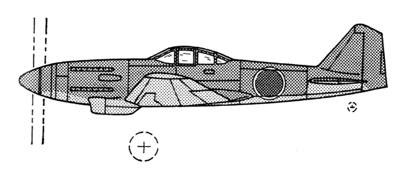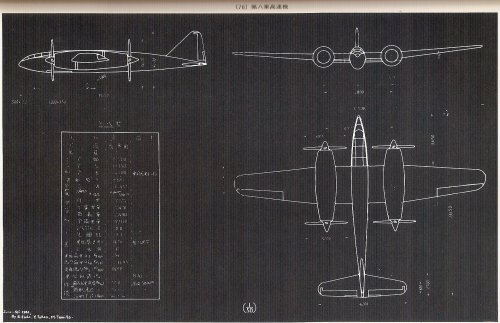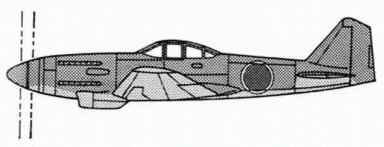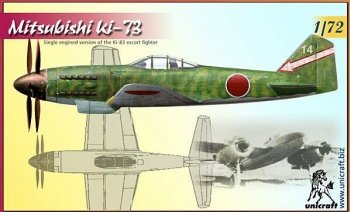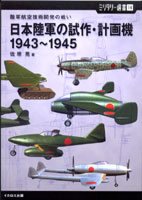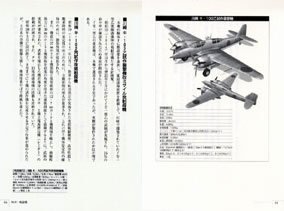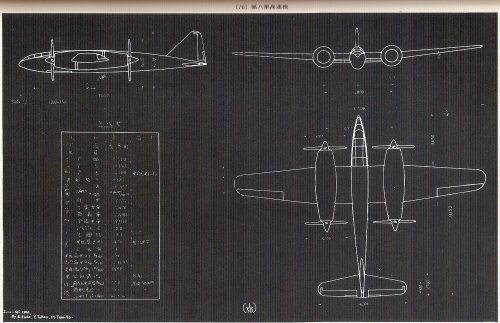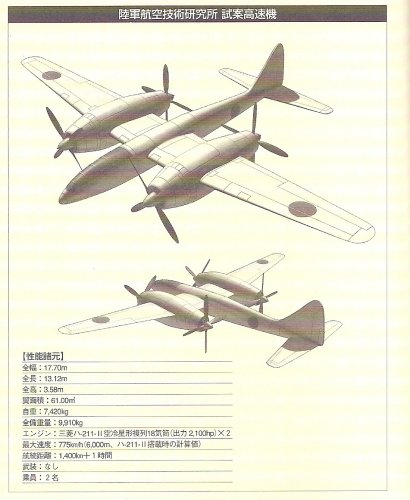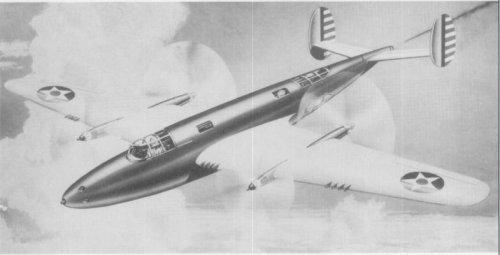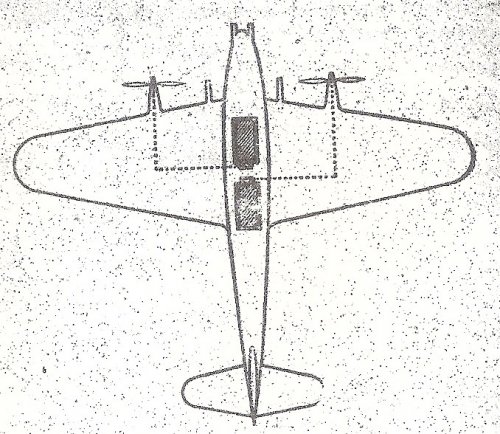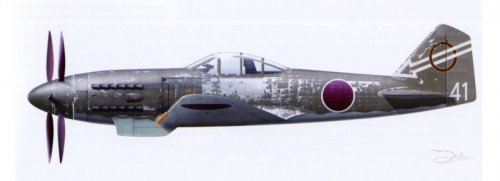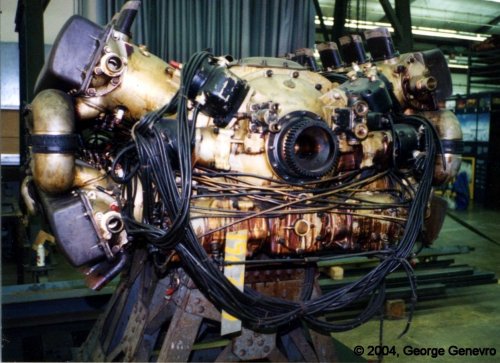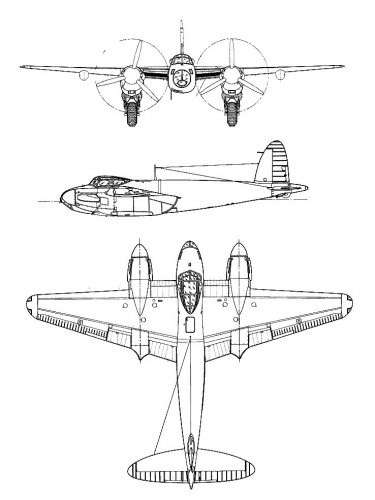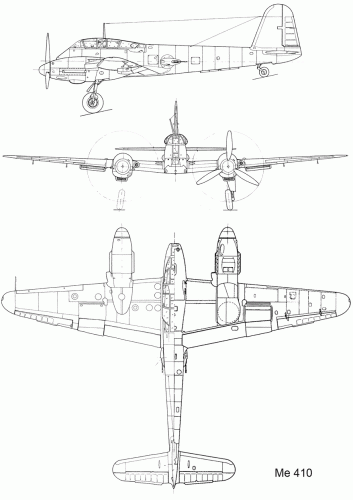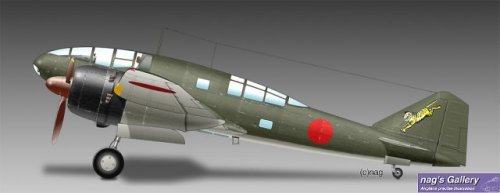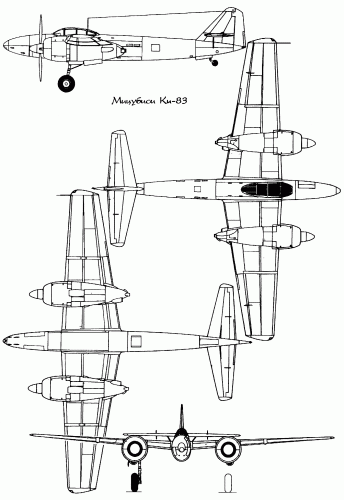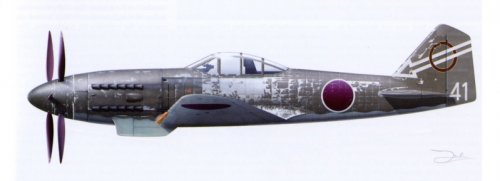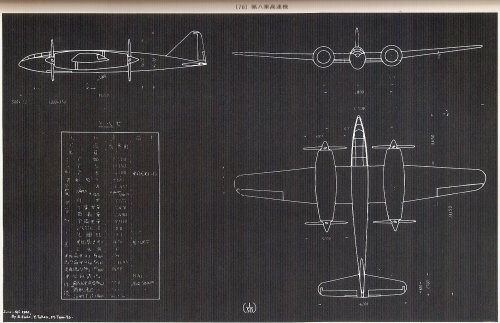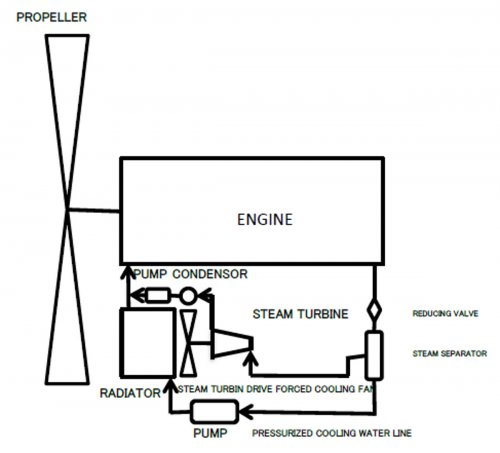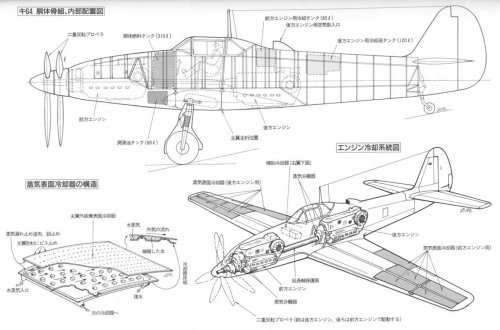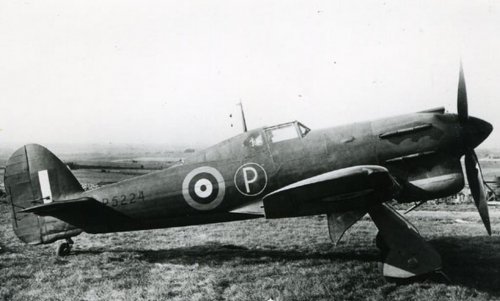You are using an out of date browser. It may not display this or other websites correctly.
You should upgrade or use an alternative browser.
You should upgrade or use an alternative browser.
Mitsubishi Ki-73 super high-speed aircraft
- Thread starter Flitzer
- Start date
J
joncarrfarrelly
Guest
Seeing as the side-view is Richard Bueschel's 'interpretation' in other words 'best guess', why not generate your own top and front-views using the side-view as a starting point?
The Ki-73 was abandoned and the designers moved on to the the Ki 83, so I'd use the wing plan-form from the Ki 83 to design the Ki 73 wings. Bueschel obviously used the Ki 83 vertical tail and canopy for 'his' Ki 73.

BTW the written description on the Hikoki site is way off, obviously the author has no clue what an H-engine is or looks like, it certainly is not tandem 12 cylinder engines. i guess he's not familiar with the Napier Sabre or other H-engines.
Cheers, Jon
The Ki-73 was abandoned and the designers moved on to the the Ki 83, so I'd use the wing plan-form from the Ki 83 to design the Ki 73 wings. Bueschel obviously used the Ki 83 vertical tail and canopy for 'his' Ki 73.

BTW the written description on the Hikoki site is way off, obviously the author has no clue what an H-engine is or looks like, it certainly is not tandem 12 cylinder engines. i guess he's not familiar with the Napier Sabre or other H-engines.
Cheers, Jon
this maybee the engine you are looking forhttp://www.enginehistory.org/Japanese/YE3-1.jpgthis is the ha74 not sure if thisn is the right one but it fits the horsepower and configertion. more herehttp://www.enginehistory.org/Japanese/japanese.htm
Pelzig
ACCESS: Secret
- Joined
- 23 October 2008
- Messages
- 448
- Reaction score
- 82
The YE3A and YE3B were X-engines. A X-engine is created by having paired V-block engines horizontally opposed to each other with the cylinders in four banks driving a common crankshaft and thus, when viewed head-on, appears as a "X".
I found one instance of these engines being used but it was in a completely fictitious design called the S-31 Kurowashi which appeared in a 1944 or 1945 issue of the Japanese magazine "Sora".
joncarrfarrelly will be happy to know the Ki-73 in my upcoming book on Japanese x-planes, has been fully updated in regards to H-engines. Perhaps I'll get around to editing the Hikoki:1946 website to correct it but a looming due date for the publication takes precedence!
I found one instance of these engines being used but it was in a completely fictitious design called the S-31 Kurowashi which appeared in a 1944 or 1945 issue of the Japanese magazine "Sora".
joncarrfarrelly will be happy to know the Ki-73 in my upcoming book on Japanese x-planes, has been fully updated in regards to H-engines. Perhaps I'll get around to editing the Hikoki:1946 website to correct it but a looming due date for the publication takes precedence!
shaba said:this maybee the engine you are looking forhttp://www.enginehistory.org/Japanese/YE3-1.jpgthis is the ha74 not sure if thisn is the right one but it fits the horsepower and configertion. more herehttp://www.enginehistory.org/Japanese/japanese.htm
me too!! ;Djoncarrfarrelly will be happy to know the Ki-73 in my upcoming book on Japanese x-planes, has been fully updated in regards to H-engines. Perhaps I'll get around to editing the Hikoki:1946 website to correct it but a looming due date for the publication takes precedence!
windswords
ACCESS: Secret
- Joined
- 19 May 2009
- Messages
- 389
- Reaction score
- 218
I did google search for Ki-73 and only found to references two it with some background info but no drawings:
http://www.daveswarbirds.com/Nippon/aircraft/Steve.htm
'The Ki-73 was an earlier attempt to meet the same specification for a long-range escort fighter that was later developed as the Ki-83. The Ki-73, however, had a single-engine configuration as opposed the later Ki-83's twin engines. When development problems with the 2,600 hp Mitsubishi Ha-203-II engine caused a delay in the program the Ki-73 project was abandoned, and the Ki-83 project began as its replacement. However, based upon captured documents the Allies believed that the Ki-73 was about to enter service with the Japanese Army, and gave it the Allied codename of "Steve".'
http://www.historyofwar.org/articles/weapons_mitsubishi_ki-73.html
"The Mitsubishi Ki-73 was a design for a single-engined long range escort fighter, produced in response to a Japanese Army specification issued in May 1943. The Ki-73 was designed by Tomio Kubo, who was also responsible for the Ki-46 Dinah and Ki-83 twin engined fighter. It was to have been powered by the 2,600hp Mitsubishi Ha-203-II twenty four cylinder horizontal H liquid-cooled engine, but this engine was plagued by development problems. As a result the Ki-73 never progressed beyond the design stage, and Tomio Kubo moved on to the twin engined Ki-83, which did at least reach the prototype stage. Despite never having been produced, the Ki-73 was given an Allied code name – ‘Steve’ – because captured documents suggested that the aircraft was about to enter service. "
Does anyone have any drawings or an artist's rendering of this aircraft?
http://www.daveswarbirds.com/Nippon/aircraft/Steve.htm
'The Ki-73 was an earlier attempt to meet the same specification for a long-range escort fighter that was later developed as the Ki-83. The Ki-73, however, had a single-engine configuration as opposed the later Ki-83's twin engines. When development problems with the 2,600 hp Mitsubishi Ha-203-II engine caused a delay in the program the Ki-73 project was abandoned, and the Ki-83 project began as its replacement. However, based upon captured documents the Allies believed that the Ki-73 was about to enter service with the Japanese Army, and gave it the Allied codename of "Steve".'
http://www.historyofwar.org/articles/weapons_mitsubishi_ki-73.html
"The Mitsubishi Ki-73 was a design for a single-engined long range escort fighter, produced in response to a Japanese Army specification issued in May 1943. The Ki-73 was designed by Tomio Kubo, who was also responsible for the Ki-46 Dinah and Ki-83 twin engined fighter. It was to have been powered by the 2,600hp Mitsubishi Ha-203-II twenty four cylinder horizontal H liquid-cooled engine, but this engine was plagued by development problems. As a result the Ki-73 never progressed beyond the design stage, and Tomio Kubo moved on to the twin engined Ki-83, which did at least reach the prototype stage. Despite never having been produced, the Ki-73 was given an Allied code name – ‘Steve’ – because captured documents suggested that the aircraft was about to enter service. "
Does anyone have any drawings or an artist's rendering of this aircraft?
Pelzig
ACCESS: Secret
- Joined
- 23 October 2008
- Messages
- 448
- Reaction score
- 82
Here is a pic:

It comes from Mikesh's Japanese Aircraft:Code Names & Designations.
The drawing from Mikesh's book was actually derived from Richard Bueschel’s 1966 book Japanese Code Names. The illustration was based on the Ki-83 on the assumption that Tomio Kubo would have used aspects of the Ki-73 in the Ki-83.
What the Ki-73 really looked like has not been determined.
It comes from Mikesh's Japanese Aircraft:Code Names & Designations.
The drawing from Mikesh's book was actually derived from Richard Bueschel’s 1966 book Japanese Code Names. The illustration was based on the Ki-83 on the assumption that Tomio Kubo would have used aspects of the Ki-73 in the Ki-83.
What the Ki-73 really looked like has not been determined.
- Joined
- 7 June 2009
- Messages
- 532
- Reaction score
- 159
A little more info here: http://www.j-aircraft.org/xplanes/hikoki_files/ki73.html
Vietcong
Avation Enthusiast from VN
Is any one have 3views of the Ki 73.It also the fighter project similar to ki-64
blackkite
Don't laugh, don't cry, don't even curse, but.....
- Joined
- 31 May 2007
- Messages
- 8,822
- Reaction score
- 7,725
To find 3views of the Mitsubishi Ki 73 super high speed(750km/h) aircraft is very difficult even in Japan.Vietcong said:Is any one have 3views of the Ki 73.It also the fighter project similar to ki-64
It's engine was two Mitsubishi design liquid cooling H shape 24 cylinder HA 206, 2,600HP in take off.
(Source:All the Experimental Aircraft in Japanese Army,KANTOSHA JAPAN)
Ed's JAPANESE SECRET PROJECT has very beautiful Ki-73 colored side view.(27p)
It's single engine aircraft.
Ki-73 had twin engine or single engine? That's the question.
Vietcong
Avation Enthusiast from VN
I already saw it in Hikoki 1946 siteblackkite said:To find 3views of the Mitsubishi Ki 73 super high speed(750km/h) aircraft is very difficult even in Japan.Vietcong said:Is any one have 3views of the Ki 73.It also the fighter project similar to ki-64
It's engine was two Mitsubishi design liquid cooling H shape 24 cylinder HA 206, 2,600HP in take off.
(Source:All the Experimental Aircraft in Japanese Army,KANTOSHA JAPAN)
Ed's JAPANESE SECRET PROJECT has very beautiful Ki-73 colored side view.(27p)
It's single engine aircraft.
Ki-73 had twin engine or single engine? That's the question.
Pelzig
ACCESS: Secret
- Joined
- 23 October 2008
- Messages
- 448
- Reaction score
- 82
The Ki-73 used a horizontal H-engine. As a whole, the entire unit (Mitsubishi Ha-203-II) is considered one engine. But the design of the Ha-203-II uses two flat engines, one on top of the other, and geared together.
Cheers,
Ed
Cheers,
Ed
Vietcong said:I already saw it in Hikoki 1946 siteblackkite said:To find 3views of the Mitsubishi Ki 73 super high speed(750km/h) aircraft is very difficult even in Japan.Vietcong said:Is any one have 3views of the Ki 73.It also the fighter project similar to ki-64
It's engine was two Mitsubishi design liquid cooling H shape 24 cylinder HA 206, 2,600HP in take off.
(Source:All the Experimental Aircraft in Japanese Army,KANTOSHA JAPAN)
Ed's JAPANESE SECRET PROJECT has very beautiful Ki-73 colored side view.(27p)
It's single engine aircraft.
Ki-73 had twin engine or single engine? That's the question.
blackkite
Don't laugh, don't cry, don't even curse, but.....
- Joined
- 31 May 2007
- Messages
- 8,822
- Reaction score
- 7,725
In 1940, the IJA's Aviation Technology Research Institute established the plan for research aircraft including super high speed aircraft. The mission of this super high speed aircraft was reconnaissance to enemy aircraft base. This aircraft was a 2 seater, combat radius was 6000km! (600km?)+1hour, faster than any existing aircraft, service ceiling was over 5000m, no limitation for take off and landing runs. At the beginning, the IJA's Aviation Technology Research Institute thought that the first flight date of this aircraft was June 1941, later corrected May 1943 while Mitsubishi thought that the day was middle of 1943.The IJA 's Aviation Technology Research Institute ordered Mitsubishi that the top speed was over 750km/h, the engine were two HA211 or HA203. This aircraft had no armaments, poor maneuverability. Mitsubishi planned that the engines were two HA203 H shape liquid cooling 24 cylinder engine which had 2600hp take off power. The propellers were contra rotating double type. This aircraft was never completed.
Source : All the Experimental Aircraft in Japanese Army, Kantosha
Source : All the Experimental Aircraft in Japanese Army, Kantosha
blackkite
Don't laugh, don't cry, don't even curse, but.....
- Joined
- 31 May 2007
- Messages
- 8,822
- Reaction score
- 7,725
Nario Ando (the IJA's engineer of the No.1 IJA aviation technology research institute) said that if this aircraft (planned by No.1 IJA aviation technology research institute) had Mitsubishi HA-211 engine, it would become one alternative design for Ki-73 high speed aircraft which ordered Mitsubishi to develop.Top speed were 750km/h(HA-45) and 775km/h(HA-211).
Attachments
blackkite
Don't laugh, don't cry, don't even curse, but.....
- Joined
- 31 May 2007
- Messages
- 8,822
- Reaction score
- 7,725
I think that following information are mistake.
http://www.daveswarbirds.com/Nippon/aircraft/Steve.htm
http://www.unicraft.biz/bigph3/ki73-arnold.htm
http://www.daveswarbirds.com/Nippon/aircraft/Steve.htm
http://www.unicraft.biz/bigph3/ki73-arnold.htm
Attachments
The black and white sideview is probably taken from R.Mikesh book
'Japanese aircraft Codenames and designations'
As far as I found , the type was cancelled at a very early stage
in it's development thus much of the illustration must be guesswork....
'Japanese aircraft Codenames and designations'
As far as I found , the type was cancelled at a very early stage
in it's development thus much of the illustration must be guesswork....
blackkite
Don't laugh, don't cry, don't even curse, but.....
- Joined
- 31 May 2007
- Messages
- 8,822
- Reaction score
- 7,725
Thanks my dear lark!
I imagine that Mitsubishi failed to develop HA203 engine, and Ki-73 project was merged into Ki-83 project. Planned Ki-73 shape might have been similar to Ki-83 with HA203 engine.
http://www.horae.dti.ne.jp/~foxone/194.htm
I imagine that Mitsubishi failed to develop HA203 engine, and Ki-73 project was merged into Ki-83 project. Planned Ki-73 shape might have been similar to Ki-83 with HA203 engine.
http://www.horae.dti.ne.jp/~foxone/194.htm
blackkite
Don't laugh, don't cry, don't even curse, but.....
- Joined
- 31 May 2007
- Messages
- 8,822
- Reaction score
- 7,725
There is a opinion that "Ki-73 had two designs, a double engine design and a single engine design. The decision of engine number was
suspended." :-\
Source : The IJA's experimental and projected aircrafts 1943~1945(日本陸軍の試作・計画機 1943~1945) by Hikaru Sahara(佐原 晃), IKAROS PUBLICATIONS LTD., ISBN4-87149-801-8 C0056
suspended." :-\
Source : The IJA's experimental and projected aircrafts 1943~1945(日本陸軍の試作・計画機 1943~1945) by Hikaru Sahara(佐原 晃), IKAROS PUBLICATIONS LTD., ISBN4-87149-801-8 C0056
Attachments
blackkite
Don't laugh, don't cry, don't even curse, but.....
- Joined
- 31 May 2007
- Messages
- 8,822
- Reaction score
- 7,725
"For Ki-83 project, Mitsubishi offered single engine aircraft sacrificed speed performance, but the IJA insisted high speed performance, Ki-83 became twin engine aircraft"
Source : The IJA's aircrafts, GAKKEN, ISBN978-4-05-606220-5
So I think that twin engine design for super high speed aircraft such as Ki-73 was proper.
Source : The IJA's aircrafts, GAKKEN, ISBN978-4-05-606220-5
So I think that twin engine design for super high speed aircraft such as Ki-73 was proper.
Pelzig
ACCESS: Secret
- Joined
- 23 October 2008
- Messages
- 448
- Reaction score
- 82
You are correct in that the failure of Mitsubishi to deliver the Ha-203-II engine, Tomio Kubo had to abandon the Ki-73. As lark mentioned, the illustration of the Ki-73 was first shown in Richard Bueschel's Japanese Code Names which was released in 1966. The artist made the assumption that Kubo may have used aspects of the Ki-73 in his later Ki-83 design. In 1944, the U.S. knew of the Ki-73 (but didn't know it had been shelved) and gave it the code name Steve. As far as I know, there was no picture created by Allied intelligence for the Ki-73 so Bueschel's art may have been the first stab at it.
blackkite said:Thanks my dear lark!
I imagine that Mitsubishi failed to develop HA203 engine, and Ki-73 project was merged into Ki-83 project. Planned Ki-73 shape might have been similar to Ki-83 with HA203 engine.
http://www.horae.dti.ne.jp/~foxone/194.htm
blackkite
Don't laugh, don't cry, don't even curse, but.....
- Joined
- 31 May 2007
- Messages
- 8,822
- Reaction score
- 7,725
The IJA's Aviation Technology Research Institute plan for super high speed reconnaissance aircraft.
Wing span : 17.7m, Length : 13.12m, Height : 3.58m, Wing area : 61 square meter : Empty weight : 7420kg, Gross weight : 9910kg, Engine : Mitsubishi HA-211-2(2100HP) ×4, Maximum speed : 775km/h(6000m), Range : 1400km+1hour, Crew : 2
Source : The IJA's experimental and projected aircrafts 1943~1945(日本陸軍の試作・計画機 1943~1945) by Hikaru Sahara(佐原 晃), IKAROS PUBLICATIONS LTD., ISBN4-87149-801-8 C0056
This drawing's front engine cowl flap position and after engine cooling air inlet position are different from original black and white 3 side view.
The original design had the good shape for after engine cooling.
Wing span : 17.7m, Length : 13.12m, Height : 3.58m, Wing area : 61 square meter : Empty weight : 7420kg, Gross weight : 9910kg, Engine : Mitsubishi HA-211-2(2100HP) ×4, Maximum speed : 775km/h(6000m), Range : 1400km+1hour, Crew : 2
Source : The IJA's experimental and projected aircrafts 1943~1945(日本陸軍の試作・計画機 1943~1945) by Hikaru Sahara(佐原 晃), IKAROS PUBLICATIONS LTD., ISBN4-87149-801-8 C0056
This drawing's front engine cowl flap position and after engine cooling air inlet position are different from original black and white 3 side view.
The original design had the good shape for after engine cooling.
Attachments
- Joined
- 26 May 2006
- Messages
- 34,940
- Reaction score
- 15,830
blackkite said:The IJA's Aviation Technology Research Institute plan for super high speed reconnaissance aircraft.
Wing span : 17.7m, Length : 13.12m, Height : 3.58m, Wing area : 61 square meter : Empty weight : 7420kg, Gross weight : 9910kg, Engine : Mitsubishi HA-211-2(2100HP) ×4, Maximum speed : 775km/h(6000m), Range : 1400km+1hour, Crew : 2
Source : The IJA's experimental and projected aircrafts 1943~1945(日本陸軍の試作・計画機 1943~1945) by Hikaru Sahara(佐原 晃), IKAROS PUBLICATIONS LTD., ISBN4-87149-801-8 C0056
This drawing's front engine cowl flap position and after engine cooling air inlet position are different from original black and white 3 side view.
It looks like Seversky Stratosphere fighter;
http://www.secretprojects.co.uk/forum/index.php/topic,4830.msg38199.html#msg38199
Attachments
blackkite
Don't laugh, don't cry, don't even curse, but.....
- Joined
- 31 May 2007
- Messages
- 8,822
- Reaction score
- 7,725
- Joined
- 31 May 2006
- Messages
- 657
- Reaction score
- 440
It is halfway down this page
http://www.enginehistory.org/Japanese/japanese.shtml
http://www.enginehistory.org/Japanese/japanese.shtml
blackkite
Don't laugh, don't cry, don't even curse, but.....
- Joined
- 31 May 2007
- Messages
- 8,822
- Reaction score
- 7,725
Mitsubishi Ki-73 super high-speed aircraft
Mitsubishi Ki-73 super high-speed aircraft was one of the research aircraft taken up in the "line of investigation" formulated by the Japanese army in 1940.
This airplane was not a mere super high-speed research aircraft but an super high-speed double seat reconnaissance plane used for reconnaissance of an enemy airfield.
It’s service altitude was 5000 m or more, run way length had no restriction and combat radius was 600 km+1 hour.
At the beginning, although the completion target date of No. 1 of Ki-73 which the Japanese army aviation technology research institute considered was 1942 June, it was postponed until March, 1943 after that.
The completion of examination was also postponed until December, 1943.
Mitsubishi which had development announced unofficially had stood the prospect that completion of No. 1 became in mid-1943.
With the design basic essential-points proposal dated June 28, 1940 which Japanese army aviation headquarters delivered to Mitsubishi, mission, service altitude, combat radius and the number of crew members were the same as that of a line of investigation, and the maximum speed was 750 km/h or more and the engine were specified as Ha 211 or Ha 203 class.
And since it devoted at high speed, it also accepted poor take off and landing performance and poor maneuverability.
Armaments were not demanded although equipment of an air camera was directed.
Although the plan was furthered in Mitsubishi as a twin-engine plane which equipped Ha 203 engine (liquid-cooled H type 24 cylinders, 2600 H.P. of take off power) which was under development, and equipped with the Contra-Rotating Propeller, it did not result in realization.
Source : All the Experimental Aircraft in Japanese Army
I imagine that Ki-73 was planned to have skin cooler.
Mitsubishi Ki-73 super high-speed aircraft was one of the research aircraft taken up in the "line of investigation" formulated by the Japanese army in 1940.
This airplane was not a mere super high-speed research aircraft but an super high-speed double seat reconnaissance plane used for reconnaissance of an enemy airfield.
It’s service altitude was 5000 m or more, run way length had no restriction and combat radius was 600 km+1 hour.
At the beginning, although the completion target date of No. 1 of Ki-73 which the Japanese army aviation technology research institute considered was 1942 June, it was postponed until March, 1943 after that.
The completion of examination was also postponed until December, 1943.
Mitsubishi which had development announced unofficially had stood the prospect that completion of No. 1 became in mid-1943.
With the design basic essential-points proposal dated June 28, 1940 which Japanese army aviation headquarters delivered to Mitsubishi, mission, service altitude, combat radius and the number of crew members were the same as that of a line of investigation, and the maximum speed was 750 km/h or more and the engine were specified as Ha 211 or Ha 203 class.
And since it devoted at high speed, it also accepted poor take off and landing performance and poor maneuverability.
Armaments were not demanded although equipment of an air camera was directed.
Although the plan was furthered in Mitsubishi as a twin-engine plane which equipped Ha 203 engine (liquid-cooled H type 24 cylinders, 2600 H.P. of take off power) which was under development, and equipped with the Contra-Rotating Propeller, it did not result in realization.
Source : All the Experimental Aircraft in Japanese Army
I imagine that Ki-73 was planned to have skin cooler.
blackkite
Don't laugh, don't cry, don't even curse, but.....
- Joined
- 31 May 2007
- Messages
- 8,822
- Reaction score
- 7,725
To combine with these images, we can imagine Ki-73 shape.
Attachments
blackkite
Don't laugh, don't cry, don't even curse, but.....
- Joined
- 31 May 2007
- Messages
- 8,822
- Reaction score
- 7,725
I think that it's possible to use steam turbine drive forced cooling fan cooled rather small radiator to reduce drag same as Kawanishi K60 flying boat which had same engine(ME2A) instead of skin cooler.
In 1941, the IJN ordered Kawanishi to develop K60 flying boat which had 9269km(5000n.m) range to go and return Hawaii from Japan and 80ton gross weight. The engine were 4×Mitsubishi Nu engine which combined two ME2A H24 liquid cooling engine. Nu engine's power was 5000hp each. Nu engine had steam turbine drive forced cooling fan. In 1942, K60 was cancelled because there were no reason for existence of flying boat. Also Nu engine was cancelled.
In 1941, the IJN ordered Kawanishi to develop K60 flying boat which had 9269km(5000n.m) range to go and return Hawaii from Japan and 80ton gross weight. The engine were 4×Mitsubishi Nu engine which combined two ME2A H24 liquid cooling engine. Nu engine's power was 5000hp each. Nu engine had steam turbine drive forced cooling fan. In 1942, K60 was cancelled because there were no reason for existence of flying boat. Also Nu engine was cancelled.
Attachments
blackkite
Don't laugh, don't cry, don't even curse, but.....
- Joined
- 31 May 2007
- Messages
- 8,822
- Reaction score
- 7,725
Hi! My very poor image for Ki-73 with twin HA-203 engine and skin cooler.
Perhaps wing must be moved forward direction to adjust C.G.and A.C.
Of course oil cooler must be installed at the engine nacelle under position.
Larger wing is needed compared with Ki-46 to lift heavy engines.
蒸気表面冷却器 : Steam skin cooler
Perhaps wing must be moved forward direction to adjust C.G.and A.C.
Of course oil cooler must be installed at the engine nacelle under position.
Larger wing is needed compared with Ki-46 to lift heavy engines.
蒸気表面冷却器 : Steam skin cooler
Attachments
Superdinah
blackkite
Don't laugh, don't cry, don't even curse, but.....
- Joined
- 31 May 2007
- Messages
- 8,822
- Reaction score
- 7,725
Thanks a lot Justo-san.
Vertical and horizontal tail stabilizer area must be slightly enlarged(or increase tail fuselage length) to keep directional inherent stability because engine side area become very large compared with Ki-46. On the other hand, wing forward movement increase the function of both tail stabilizer for directional stability.
Only you can finish my poor idea for Ki-73 and D4Y5. Please try when you have enough time.
Vertical and horizontal tail stabilizer area must be slightly enlarged(or increase tail fuselage length) to keep directional inherent stability because engine side area become very large compared with Ki-46. On the other hand, wing forward movement increase the function of both tail stabilizer for directional stability.
Only you can finish my poor idea for Ki-73 and D4Y5. Please try when you have enough time.
blackkite
Don't laugh, don't cry, don't even curse, but.....
- Joined
- 31 May 2007
- Messages
- 8,822
- Reaction score
- 7,725
Unfortunately we have almost no data about Mitsubishi HA-203 engine.
I imagine HA-203 looks like Napier Sabre sleeve valve engine. But I doubt that HA-203 was a sleeve valve engine.
Napier Sabre has H shape 24 cylinders, but exhaust nozzles looks like 12.
Two exhaust nozzles are connected into one exhaust nozzle.
It's very hard to understand Sabre engine. Almost I can't understand it. ;D
https://en.wikipedia.org/wiki/Napier_Sabre
I imagine HA-203 looks like Napier Sabre sleeve valve engine. But I doubt that HA-203 was a sleeve valve engine.
Napier Sabre has H shape 24 cylinders, but exhaust nozzles looks like 12.
Two exhaust nozzles are connected into one exhaust nozzle.
It's very hard to understand Sabre engine. Almost I can't understand it. ;D
https://en.wikipedia.org/wiki/Napier_Sabre
Attachments
-
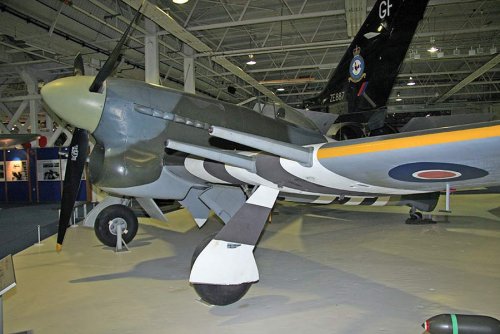 Hawker-Typhoon-1B.jpg80.5 KB · Views: 141
Hawker-Typhoon-1B.jpg80.5 KB · Views: 141 -
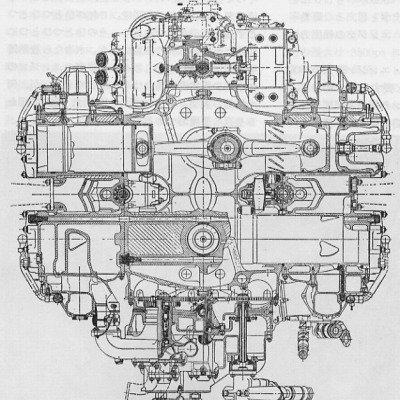 img9f244ba3p05k2k.jpg70.7 KB · Views: 104
img9f244ba3p05k2k.jpg70.7 KB · Views: 104 -
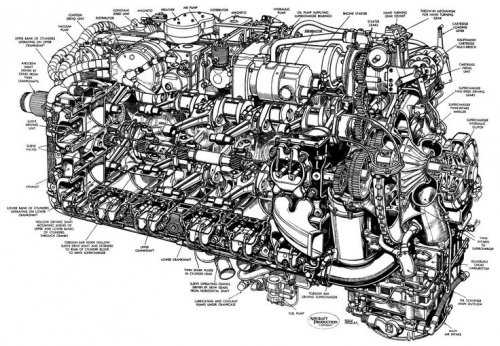 59963cb8233ac03aa81ce310829ace99.jpg125.1 KB · Views: 85
59963cb8233ac03aa81ce310829ace99.jpg125.1 KB · Views: 85 -
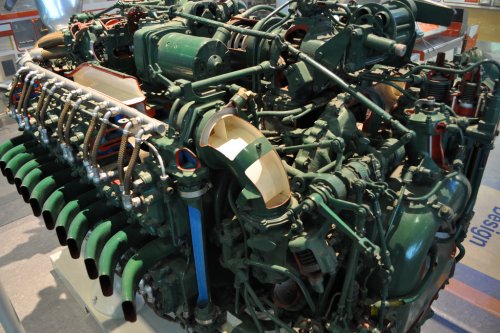 8502958263_69b066fd53_b.jpg447.3 KB · Views: 80
8502958263_69b066fd53_b.jpg447.3 KB · Views: 80 -
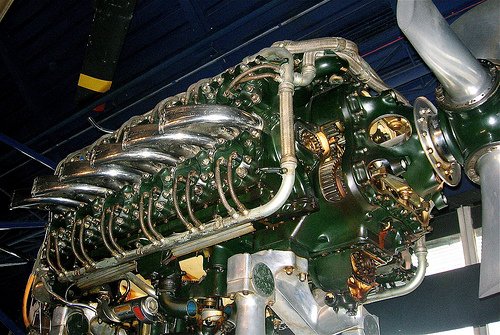 tumblr_nn8dmkhPqc1utdcaeo1_500.jpg177.1 KB · Views: 97
tumblr_nn8dmkhPqc1utdcaeo1_500.jpg177.1 KB · Views: 97 -
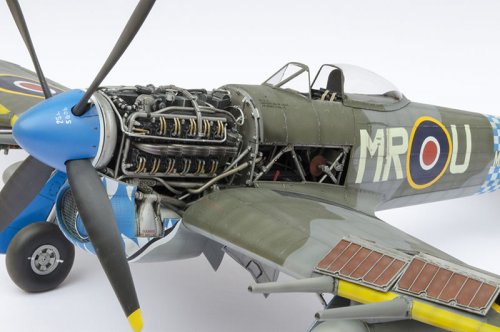 Typhoon ⅡB.jpg75.3 KB · Views: 102
Typhoon ⅡB.jpg75.3 KB · Views: 102 -
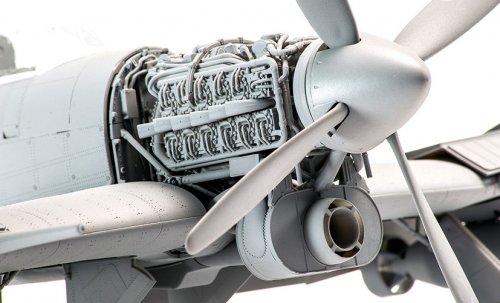 A19002-Typhoon_Primed-Detail-3.jpg142.7 KB · Views: 106
A19002-Typhoon_Primed-Detail-3.jpg142.7 KB · Views: 106 -
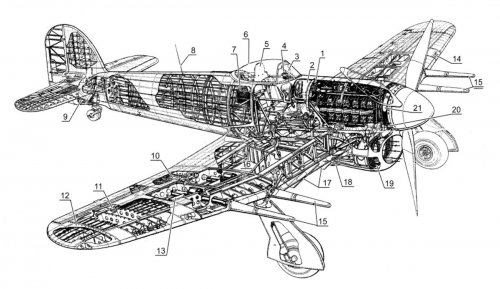 Hawker_Typhoon_ⅡB_with_Napier_Sabre_H-24_shape_engine.jpg179.5 KB · Views: 104
Hawker_Typhoon_ⅡB_with_Napier_Sabre_H-24_shape_engine.jpg179.5 KB · Views: 104
blackkite
Don't laugh, don't cry, don't even curse, but.....
- Joined
- 31 May 2007
- Messages
- 8,822
- Reaction score
- 7,725
Also Rolls Royce Vulture engine has x shape 24 cylinders, but exhaust nozzles looks like 12, too. ;D
What is the shape of Ki-73 engine exhaust nozzle?
I vote to Typhoon fighter type exhaust nozzles.
https://en.wikipedia.org/wiki/Rolls-Royce_Vulture
What is the shape of Ki-73 engine exhaust nozzle?
I vote to Typhoon fighter type exhaust nozzles.
https://en.wikipedia.org/wiki/Rolls-Royce_Vulture
Attachments
blackkite
Don't laugh, don't cry, don't even curse, but.....
- Joined
- 31 May 2007
- Messages
- 8,822
- Reaction score
- 7,725
Hi! Sleeve valve engine animation. Sorry for off topic.
https://www.youtube.com/watch?v=_vrvep_YOio
https://www.youtube.com/watch?v=J0q9l8xejrE
Wasp major push rod Over Head Valve(OHV) engine animation.
https://www.youtube.com/watch?v=Kr0AxAPeGiI
https://www.youtube.com/watch?v=_vrvep_YOio
https://www.youtube.com/watch?v=J0q9l8xejrE
Wasp major push rod Over Head Valve(OHV) engine animation.
https://www.youtube.com/watch?v=Kr0AxAPeGiI
blackkite
Don't laugh, don't cry, don't even curse, but.....
- Joined
- 31 May 2007
- Messages
- 8,822
- Reaction score
- 7,725
Very sorry. Apparently nose heavy.
This airplane engines must be hung under the wing and moved further backwards.
Correct shape is like this.
There is an opinion that development of the ki-73 was terminated before it was decided whether the number of engines would be one or two.
This airplane engines must be hung under the wing and moved further backwards.
Correct shape is like this.
There is an opinion that development of the ki-73 was terminated before it was decided whether the number of engines would be one or two.
Last edited:
Similar threads
-
-
-
-
Japanese Secret Projects:Experimental Aircraft of the IJA & IJN 1939-1945
- Started by Pelzig
- Replies: 261
-

